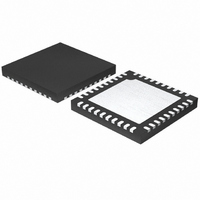ISL8103IRZ Intersil, ISL8103IRZ Datasheet - Page 10

ISL8103IRZ
Manufacturer Part Number
ISL8103IRZ
Description
IC CTRLR PWM BUCK 3PHASE 40-QFN
Manufacturer
Intersil
Datasheet
1.ISL8103IRZ-T.pdf
(28 pages)
Specifications of ISL8103IRZ
Pwm Type
Voltage Mode
Number Of Outputs
1
Frequency - Max
1.5MHz
Duty Cycle
66.6%
Voltage - Supply
4.75 V ~ 12.6 V
Buck
Yes
Boost
No
Flyback
No
Inverting
No
Doubler
No
Divider
No
Cuk
No
Isolated
No
Operating Temperature
-40°C ~ 85°C
Package / Case
40-VFQFN, 40-VFQFPN
Frequency-max
1.5MHz
Lead Free Status / RoHS Status
Lead free / RoHS Compliant
Another benefit of interleaving is to reduce input ripple
current. Input capacitance is determined in part by the
maximum input ripple current. Multiphase topologies can
improve overall system cost and size by lowering input ripple
current and allowing the designer to reduce the cost of input
capacitance. The example in Figure 2 illustrates input
currents from a three-phase converter combining to reduce
the total input ripple current.
The converter depicted in Figure 2 delivers 1.5V to a 36A
load from a 12V input. The RMS input capacitor current is
6.1A. Compare this to a single-phase converter also
stepping down 12V to 1.5V at 36A. The single-phase
converter has a 13.3A RMS input capacitor current. The
single-phase converter must use an input capacitor bank
with twice the RMS current capacity as the equivalent
three-phase converter.
Figures 24, 25 and 26 in the section entitled “Input Capacitor
Selection” on page 24 can be used to determine the input
capacitor RMS current based on load current, duty cycle,
and the number of channels. They are provided as aids in
determining the optimal input capacitor solution.
PWM Operation
The timing of each converter leg is set by the number of
active channels. The default channel setting for the ISL8103
is three. One switching cycle is defined as the time between
the internal PWM1 pulse termination signals. The pulse
termination signal is the internally generated clock signal
that triggers the falling edge of PWM1. The cycle time of the
pulse termination signal is the inverse of the switching
frequency set by the resistor between the FS pin and
ground. Each cycle begins when the clock signal commands
PWM1 to go low. The PWM1 transition signals the internal
Channel 1 MOSFET driver to turn off the Channel 1 upper
MOSFET and turn on theChannel 1 synchronous MOSFET.
In the default channel configuration, the PWM2 pulse
FIGURE 2. CHANNEL INPUT CURRENTS AND INPUT-
INPUT-CAPACITOR CURRENT
CAPACITOR RMS CURRENT FOR 3-PHASE
CONVERTER
CHANNEL 1
INPUT CURRENT
CHANNEL 2
INPUT CURRENT
CHANNEL 3
INPUT CURRENT
10
ISL8103
terminates 1/3 of a cycle after the PWM1 pulse. The PWM3
pulse terminates 1/3 of a cycle after PWM2.
If PVCC3 is left open or connected to ground, two channel
operation is selected and the PWM2 pulse terminates 1/2 of
a cycle after the PWM1 pulse terminates. If both PVCC3 and
PVCC2 are left open or connected to ground, single channel
operation is selected. The 2PH and 3PH inputs can also be
used to accomplish this function. Once a PWM pulse
transitions low, it is held low for a minimum of 1/3 cycle. This
forced off time is required to ensure an accurate current
sample. Current sensing is described in the next section.
After the forced off time expires, the PWM output is enabled.
The PWM output state is driven by the position of the error
amplifier output signal, VCOMP, minus the current correction
signal relative to the sawtooth ramp as illustrated in Figure 3.
When the modified VCOMP voltage crosses the sawtooth
ramp, the PWM output transitions high. The internal
MOSFET driver detects the change in state of the PWM
signal and turns off the synchronous MOSFET and turns on
the upper MOSFET. The PWM signal will remain high until
the pulse termination signal marks the beginning of the next
cycle by triggering the PWM signal low.
Channel Current Balance
One important benefit of mulitphase operation is the thermal
advantage gained by distributing the dissipated heat over
multiple devices and greater area. By doing this the designer
avoids the complexity of driving parallel MOSFETs and the
expense of using expensive heat sinks and exotic magnetic
materials.
In order to realize the thermal advantage, it is important that
each channel in a multiphase converter be controlled to
carry about the same amount of current at any load level. To
achieve this, the currents through each channel must be
sampled every switching cycle. The sampled currents, I
from each active channel are summed together and divided
by the number of active channels. The resulting cycle
average current, I
current demand on the converter during each switching
cycle. Channel current balance is achieved by comparing
the sampled current of each channel to the cycle average
current, and making the proper adjustment to each channel
pulse width based on the error. Intersil’s patented current-
balance method is illustrated in Figure 3, with error
correction for Channel 1 represented. In the figure, the cycle
average current, I
sample, I
The filtered error signal modifies the pulse width
commanded by V
I
correction is applied to each active channel.
ER
toward zero. The same method for error signal
1
, to create an error signal I
COMP
AVG
AVG
, provides a measure of the total load
, is compared with the Channel 1
to correct any unbalance and force
ER
.
July 21, 2008
FN9246.1
n
,












